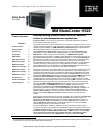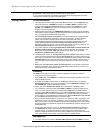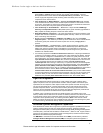
Workhorse 2-socket single- or dual-core Intel Xeon blade server
Please see the Legal Information section for important notices and information.
2.
ServerGuide
™
help maintain system availability with increased uptime.
If your customer needs highly manageable, high-performance computing power in a space-
constrained environment, the HS20 is the ideal system.
Selling Features Price/Performance
• The HS20 offers a choice of high-performance Xeon processors, from a single-core chip
with 64-bit extensions, an 800MHz front side bus and 1MB or 2MB of integrated Level 2
cache to a 32-bit dual-core ultra-low power Xeon processor with double the L2 cache
(2x1MB) and an 800MHz front side bus. This means there is an HS20 model to fit all
budgets and power requirements.
• Selected HS20 blade servers are NEBS3/ETSI-compliant and feature long-life availability.
These blades are ideal for telecom or Next Generation Network (NGN) applications such as
IPTV, IP Multimedia Subsystem (IMS) and security.
• The extremely high degree of integration in the various BladeCenter chassis eliminates
the need for internal server components, replacing numerous fans, KVM and Ethernet
cables, power supplies, external switches and other components, with a few hot-
swap/redundant components in the BladeCenter chassis itself. This integration also can
greatly reduce the amount of power consumed and heat produced, relative to an
equivalent number of 1U servers. This can significantly reduce a customer’s power bill. The
reduced datacenter footprint can also save on infrastructure cost.
• The chassis midplane provides high-speed blade-to-blade, blade-to-switch-module and
module-to-module communication internally as well as externally. The midplane in the
BladeCenter H provides four 10Gb data channels to each blade, and supports 4X
InfiniBand and 10Gb Ethernet bridge modules.
• The BladeCenter chassis use ultrahigh efficiency power supplies. Most industry-standard
servers use power supplies that are between 65-75% efficient at converting power from AC
wall current to the DC power used inside servers. BladeCenter power modules can be more
than 90% efficient. This helps save even more money for the customer, because more of
the power input is used for processing, rather than released into the data center as waste
heat.
• BladeCenter also reduces the number of parts required to run the system. Sharing fans,
systems management, floppy devices and media means fewer parts to buy, maintain, and
fewer items that can bring the solution down.
Flexibility
The HS20 has the ability to grow with a customer’s application requirements, thanks to:
• An optional second Xeon processor.
• Up to 16GB of high-speed DDR2 error checking and correcting (ECC) system memory with
optional Chipkill protection.
• Up to two internal 2.5-inch SCSI HDDs, up to two 3.5-inch SCSI HDDs in an adjacent
Storage Expansion Unit, and access to terabytes of external IBM System Storage
™
and
IBM TotalStorage
™
SAN and NAS storage devices.
In addition, the various BladeCenter chassis offer a high degree of flexibility as well:
• Any combination of Xeon processor-based HS20 and HS40 (4-processor), blades can be
used in the same chassis as Opteron processor-based LS20 blades, and IBM PowerPC
processor-based JS20 and JS21 blades. Up to 7 non-Low Voltage HS20 blades or up to 8
Low Voltage blades can be used in the BladeCenter T chassis. Depending on the blade
servers used, the various BladeCenter chassis support Microsoft Windows, Linux, IBM AIX
®
and Sun Solaris 10 operating systems in the same chassis.
• Every LS20/HS20/HS40/JS20/JS21 blade server ever released by IBM is supported in every
BladeCenter chassis ever released, going back to 2002. Every switch module released by
IBM is the same way. (Ask HP and Dell how far back their compatibility goes.) Future blades
and fabric switches are expected to continue to be compatible with previous chassis for the
foreseeable future.
• A blade server has access to as many as 10 communication switches and/or bridges in
one BladeCenter H chassis. And the switches can be Ethernet, iSCSI, InfiniBand, Fibre
Channel, Myrinet, or anything else designed and ServerProven for BladeCenter use.
Switches, bridges and interface cards are currently available from such vendors as Brocade,
Cisco, Intel, McData, Nortel, QLogic, Topspin and others, in addition to IBM.
Manageability
• The HS20 blade server includes a Baseboard Management Controller (BMC) to monitor


















